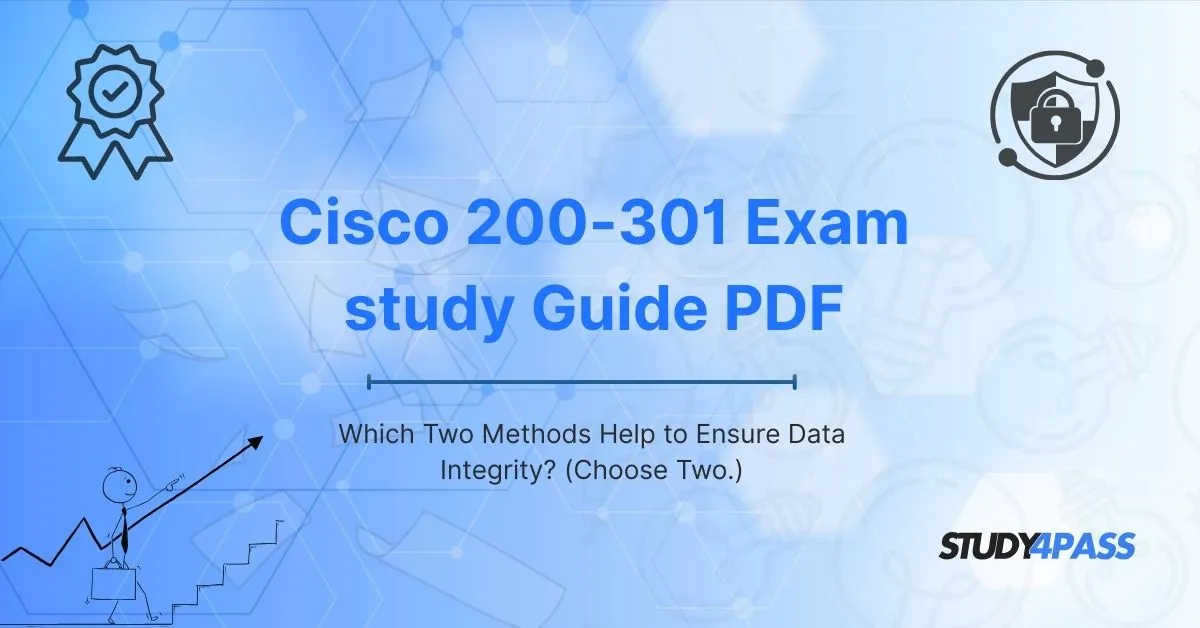Introduction To 200-301 Exam Study Guide PDF
In the world of networking and IT, ensuring data integrity is crucial. Data integrity refers to the accuracy, consistency, and reliability of data throughout its lifecycle. Whether you're preparing for the CCNA 200-301 exam or working in the field, understanding how to maintain data integrity is essential.
If you're looking for a reliable 200-301 Exam Study Guide PDF, Study4Pass provides comprehensive resources to help you master key concepts like data integrity. In this blog, we’ll explore two critical methods that help ensure data integrity, along with explanations, examples, and why they matter for your exam preparation.
What Is Data Integrity?
Before diving into the methods, let’s define data integrity:
- Data integrity ensures that data remains accurate, unaltered, and consistent during storage, retrieval, and transmission.
- Without proper data integrity measures, data can become corrupted, lost, or tampered with, leading to security risks and operational failures.
- Now, let’s discuss the two primary methods used to ensure data integrity.
Method 1: Checksums (Error Detection)
What Is a Checksum?
A checksum is a simple but effective method for detecting errors in data. It works by generating a fixed-size value (hash) based on the data being transmitted or stored.
How Checksums Ensure Data Integrity
1. Before Transmission: The sender calculates a checksum for the original data.
2. After Transmission: The receiver recalculates the checksum and compares it with the original.
If they match, the data is intact.
If they don’t match, the data has been altered or corrupted.
Example of Checksum in Networking
TCP/IP Protocol uses checksums to verify that packets arrive without errors.
File Downloads often include checksums (e.g., MD5, SHA-1) to confirm file integrity.
Why Checksums Matter for the 200-301 Exam
Understanding checksums is key for network troubleshooting and error detection.
The CCNA 200-301 Certification may test your knowledge of how checksums work in protocols like TCP/IP.
Method 2: Cyclic Redundancy Check (CRC)
What Is CRC?
A Cyclic Redundancy Check (CRC) is a more advanced error-detection technique used in networking and storage systems. It detects accidental changes to raw data by generating a polynomial-based checksum.
How CRC Ensures Data Integrity
1. Sender Side: The data is processed using a mathematical algorithm to produce a CRC code.
2. Receiver Side: The same algorithm is applied to the received data.
If the CRC codes match, the data is valid.
If they differ, corruption has occurred.
Example of CRC in Networking
Ethernet Frames use CRC-32 to detect errors in transmitted data.
Storage Devices (HDDs, SSDs) use CRC to prevent silent data corruption.
Why CRC Matters for the 200-301 Exam
The CCNA 200-301 exam may ask about error-detection mechanisms like CRC in Ethernet and other protocols.
Knowing how CRC works helps in network diagnostics and data validation.
Comparison: Checksum vs. CRC
|
Feature |
Checksum |
CRC |
|
Complexity |
Simple (basic addition) |
Complex (polynomial division) |
|
Error Detection |
Detects basic errors |
Detects more complex errors |
|
Usage |
Used in TCP/IP, file verification |
Used in Ethernet, storage systems |
|
Efficiency |
Faster but less robust |
Slower but more reliable |
Efficiency Faster but less robust Slower but more reliable
While both methods ensure data integrity, CRC is more robust for detecting errors in high-speed networks.
Other Data Integrity Techniques (Bonus)
While the CCNA 200-301 exam focuses on checksums and CRC, other methods also ensure data integrity:
1. Hashing (e.g., SHA-256, MD5)
- Used for data authentication and password storage.
- Unlike checksums, hashes are irreversible (cannot retrieve original data).
2. Digital Signatures
- Ensures data authenticity and non-repudiation.
- Used in SSL/TLS certificates for secure web browsing.
3. RAID (Redundant Array of Independent Disks)
- Protects against disk failures by storing parity data.
- These are more advanced topics but worth exploring for a deeper understanding of data integrity.
Why Is Data Integrity Important for the 200-301 Exam?
The CCNA 200-301 Exam tests your knowledge of network fundamentals, including:
- Error detection and correction (Checksum, CRC)
- Data transmission reliability (TCP vs. UDP)
- Security best practices (encryption, hashing)
By mastering these concepts, you’ll be better prepared for exam questions like:
Which two methods help to ensure data integrity? (Answer: Checksum & CRC)
What is the purpose of a checksum in TCP?
How Study4Pass Helps You Prepare for the 200-301 Exam
If you're looking for a 200-301 exam study guide PDF, Study4Pass offers:
- Comprehensive CCNA 200-301 study materials (PDFs, practice tests, video tutorials)
- Real exam questions with detailed explanations
- Cheat sheets for quick revision on checksums, CRC, and more
- Hands-on labs to practice networking concepts
With Study4Pass, you’ll gain the confidence to ace the exam and apply these concepts in real-world scenarios.
Conclusion
Ensuring data integrity is a fundamental aspect of networking, and the CCNA 200-301 exam tests your understanding of these principles. The two primary methods to ensure data integrity are: Checksums – Simple error detection used in TCP/IP. Cyclic Redundancy Check (CRC) – Advanced error detection used in Ethernet and storage.
Special Discount: Offer Valid For Limited Time “200-301 Exam Prep Practice Test”
Sample Questions for Cisco 200-301 Exam Prep Practice Tests
Actual exam question from Cisco's 200-301 Exam
Which of the following is the most effective way to prepare for the Cisco 200-301 exam?
A) Reading a basic networking book
B) Watching online videos without taking notes
C) Using a comprehensive 200-301 exam study guide PDF
D) Practicing random topics without a structured plan


